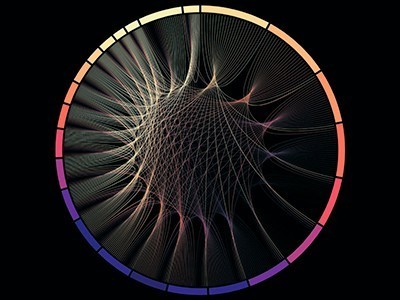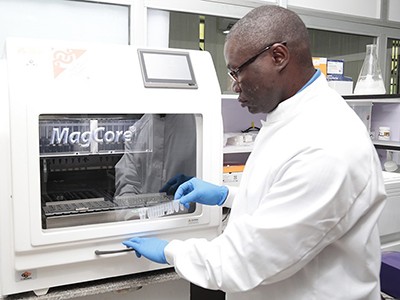
Jacques Lucien Monod (s.9.2.1910 Pariisi, k.30.5.1976 Cannes) oli yksi viime vuosi- sadan ansioituneimpia biologeja,sanotaan viiden parhaan joukossa: Watson, Pavlov, Fields, Monod...). Häntä pidetään nykyaikaisen molekyylibiologian luojana ja lähetti-RNA-molekyylimekanismin löytäjänä. Nobelin hän sai 1965 entsyymien ja virusten syntetisaation geneettisestä ohjauksesta.
Hän oli sodan aikana Ranskan vastarintarintaliikkeen kommunistisen sotilaallisen haaran johtaja. Hän oli omana aikanaan yleissivistykseen kuuluva uskonnonvastai-nen luonnonfilosofi varsinkin teoksellaan "Sattuma ja välttämättömyys", ja ainoa dia-lektiikan julkivastustaja, joka sai filosofisen teoksensa laajaan levitykseen venäjäksi Neuvostoliitossa. Hän pitää kaikkea perimmiltään satunnaisena ja mm.´totuutta "mo- raalisena käsitteenä". Marxin ja Leninin kanssa hänen käsityksensä varsinkaan van-hemmiten eivät aina natsanneet yhteen."Eurokommunistit" lainasivat omiin tarkoituk- siinsa hänen sanakäänteitään, on mm. "eettistä totuutta" ja "eettistä sosialismia"...
Joe Bidenin tiedeneuvonantajien johtaja YLE1:n PRISMASSA.
/tiede.fi/s3fs-public/discussion_topic_image/lander_1.jpg?itok=0iZ6qds3)
Joe-setä Bidenin valitsema uusi tiedeneuvonantajajohtaja Eric Landerkin esiintyy hyvässä pelkistetyssä dokumentissa. Hän toimi valtiollisessa ihmisen genomin kar-toitusohjelmassa, jota johti hallinnollisesti NIH:n johtaja Fances Collins. Yksityistä johti muuan Craig Venter. Lander on peruskoulutukseltaan matemaatikko. Projektin johtava geneetikko oli hänen veljensä Arthur Lander.
Mukana ohjelmassa on myös DNA:n keksijä,se heistä,joka oli intuitiivisesti koko ajan oikeassa, mitä etsitään,James Watson.Hänkin on ollut tiedeneuvonantajien johtajan hommassakin, Bushin aikana,mutta sai potkut kesken kauden, kun puhui rotuvitsejä, vähän ennen kauden loppua 2007. Tilalle tuli varapuheenjohtajan paikalta Eric Lander, joka on siis hommassa nyt toista kertaa.
Ohjelmassa sanoo pari sanaa myös yksi puoskaritieteilijä: Ylähuoneen lordi Matt "Trofim" Ridley, joka luulee, että geenit sellaisenaan olisivat myös oppimisen ja muistamisen mekanismi... Toivottavasti tämä ei tiedä mitään huonoa ohjelman jatkon kannalta...
https://areena.yle.fi/1-50525744
" Matka geenien maailmaan
Jakso 1: Tieteen uranuurtajat
1/4.Sarjassa perehdytään geenitutkimuksen historiaan sen uranuurtajien kautta sekä uusien hoitomenetelmien uskomattomiin mahdollisuuksiin. Voimmeko tulevaisuudes- sa poistaa perinnölliset sairaudet ja mitkä ovat geenitieteen eettiset ongelmat? Ken Burnsin tuottamassa sarjassa kuullaan sekä asiantuntijoita että inhimillisiä tarinoita geeniterapian kokemuksista.
T: Florentine Films/WETA, Yhdysvallat
Lander otti samalla hatkat MIT-"yliopistosta" (mutta jatkaa Harvardissa).
https://www.broadinstitute.org/bios/eric-s-lander
Eric S. Lander, Ph.D. President and Founding Director, on leave

Valokuva, joka todisti kaksoiskieteen.
Sarjan toisessa osassa esitetään geneettisen koodin syntyhistoriaa ja myös siihen ladattuja perusteettomia odotuksia. Käsittely alkaa tutkimusryhmän kokoamisesta, jossa oli oikeastaan vain yksi varsinainen "nykyaikainen geneetikko" James Wat-son, jolla oli tutkimuskohteesta idea,jota lähdettiin todistamaan oikeaksi tai vääräksi.
https://fi.wikipedia.org/wiki/James_D._Watson
Fyysikkotaustainen Francis Crick oli armeijan tutkija, joka organisoi projektin ja hankki sille resurssit ja loput henkilöt. https://fi.wikipedia.org/wiki/Francis_Crick
Maurice Wilkins ja Rosalind Franklin olivat molekyylivalokuvaajia.
https://fi.wikipedia.org/wiki/Maurice_Wilkins
https://fi.wikipedia.org/wiki/Rosalind_Franklin
Valmiiksi tiedettiin, että perinnöllisyysaine on DNA ja siitä tiedettiin, että se koostuu neljästä aminohaposta adeniinista, guamiinista, sytosiinista ja tymiinistä. Lisäksi tie-dettiin niiden sidotuista määräsuhteista. Nämä oli selvittänyt erikseen Nobel-palkittu amerikkalainen biokemisti Linus Pauling, jota ohjelmassa ei mainita. Myös hän oli tutkinut molekyylivalokuvaustakin. Pauling oli kietäytynyt atomipommityöryhmästä ja hän sai myös Nobelin rauhanpalkinnon tiedemieten sodan- ja ydinaseidenvastaisen Pugwash-rauhanliikkeen perustamisesta. Kaikki eivät tästä tykänneet ja hänen pas-sinsakin pantiin välillä hyllylle. Hänellä teetettiin toisarvoisia "käytännön" hommia kuiten C-vitamiinilääkkeiden kehittämistä. https://fi.wikipedia.org/wiki/Linus_Pauling
Tutkimusongelma koski siis ennen kaikkea sitä, miten nuo neljä aminohappoa oli-vat järjestäytyneet ketjuiksi. Monet mm. Pauling olivat kannattaneet kolmoiskierret-tä. Kaksoiskirteen todisti lopulta Franklinin valokuva, jonka Watson sai käsiinsä Cric-kiltä. Watson ei siitä kuvasta sitä kaksoiskierrettä keksinyt. Siitä oli päristy paljonkin, mutta oli mm. pidetty ongelmallisena, miten sellaista voitaisiin "lukea". Se ongelma raykaistiinkin vasta myöhemmin ja muualla.
https://areena.yle.fi/1-50525742
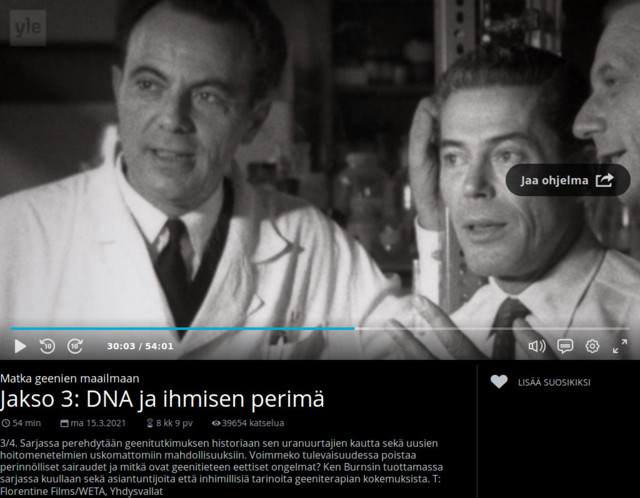
Sarjan kolmannennessa osassa pääpaino on DNA:n toimintamekanismilla.
https://areena.yle.fi/1-50525745
Sen selvittäjiksi katsotaan lähetti-RNA-molekyylin keksijät Jacques Monod ja Fran-cois Jacob. Yhteisen Nobelin vielä André Lwowin kanssa he saivat vuonna 1965 "entsyymien ja virusten synnyn geneettisestä kontrollista".
Erityisesti Jacob esitti, että "geenien luenta sääntelee entsyymitasoa soluissa" (ja jokin muu sääntelee sitä luentaa), mikä on vastakkainen ns. homeostaattiselle peri-aatteelle, että "geenistä luetaan aineita vain just sen verran kuin tarvitaankin" (ja jäl-kikäteen,kun niitä ensin on käytetty). Homeostaasillakin on kuitenkin taatusti puolen-sa, koska sitä voidaan säädellä kemiallisesti ulkopuoleltakin mm. hormoneilla. Mutta jokin sen homeostaasitasonkin aina määrää.
https://en.wikipedia.org/wiki/Fran%C3%A7ois_Jacob
" François Jacob (17 June 1920-19 April 2013) was a French biologist who, together with Jacques Monod, originated the idea that control of enzyme levels in all cells occurs through regulation of transcription. "...
https://www.cell.com/current-biology/fulltext/S0960-9822(15)00606-5
" Who discovered messenger RNA?
On May 13,1961, two articles appeared in Nature, authored by a total of nine people, including Sydney Brenner, François Jacob and Jim Watson, announcing the isolation of messenger RNA (mRNA) [1,2]. In the same month, François Jacob and Jacques Monod published a review in Journal of Molecular Biology in which they put mRNA into a theoretical context, arguing for its role in gene regulation [3]. Aside from the technical prowess involved, these papers were feats of the imagination, for they represented an entirely new way of thinking about gene function.
Although insight and hard thinking played a decisive role in developing this new view of life, this work built upon over a decade of research by many groups in the US and Europe as they attempted to unravel how the genetic message gets from DNA to produce proteins. ... "
Geenien keskinäistä nkytkentää ja sääntelyä he selttävät erityisellä operoniteorialla.
https://encyclopedia2.thefreedictionary.com/operon
" Operon
a group of functionally related genes that controls the synthesis of enzyme proteins that are associated with the successive stages of any biochemical process (see GENE). The concept of an operon as part of the theory of genetic organization and regulation was advanced in 1961 by the French scientists F. Jacob and J. Monod, on the basis of experiments with the synthesis of inducible enzymes in Escherichia coli mutants. An operon exerts its regulatory effect during the transcription phase of pro-tein synthesis, that is, when genetic information is being transcribed from deoxyribo-nucleic acid (DNA) to the corresponding portion of messenger ribonucleic acid (mRNA) (seeDEOXYRIBONUCLEIC ACID).
The promoter site is usually located at the beginning of the operon. This is where the enzyme RNA polymerase binds in order to bring about the transcription of the DNA in that operon. Behind the promoter site is the operator—the portion of DNA with which a regulatory protein, or repressor, interacts. The rest of the operon consists of structu-ral genes that contain information about the amino-acid sequence of the polypeptide chains in proteins. The synthesis of the repressor proteins is controlled by regulator genes, which are not necessarily associated with the operon whose effect they re-press. By interacting with an operator, a repressor influences the rate of transcription of structural genes.
A repressor is capable of both recognizing the sequence of bases in operator DNA and interacting with substances of low molecular weight called effectors. The effec-tors are generally substrates or products of the enzymes that are formed by the par-ticular operon in question.Effectors greatly alter a repressor’s affinity for an operator; some effectors diminish this affinity, while others enhance it. The binding of a repres-sor to an operator prevents RNA polymerase from moving along the operon. As a re-sult, the synthesis of mRNA is inhibited. Removal of the repressor from the operator activates the operon.Thus,the operator controls the activity of the operon as a whole.
The process that has just been described is an example of the negative control of gene expression. Gene expression is also under positive control, in which case an activator protein becomes attached to the initial part of the operon - in front of the promoter; from this site, the protein initiates the transcription of the operon. The end of the operon is a series of nucleotides to which a specific protein is bound.This pro-tein,called a terminator,halts the synthesis of RNA.Although these mechanisms have been studied only in prokaryotes,the cells of higher organisms are believed to exhibit similar mechanisms.
The concept of the operon has proven to be very fruitful in molecular genetics. The theory has been confirmed by many researchers,who used both genetic and bioche-mical approaches. The discovery of operons proves that the activity of a gene in a cell is ordered and dependent on both external conditions and the activity of other genes. The concept of the operon also helps explain how the genetic apparatus of a cell is able to react adequately to changes in external conditions. "
https://fi.wikipedia.org/wiki/Operoni
https://encyclopedia2.thefreedictionary.com/Monod%2c+Jacques+Lucien
https://monoskop.org/images/9/99/Monod_Jacques_Chance_and_Necessity.pdf
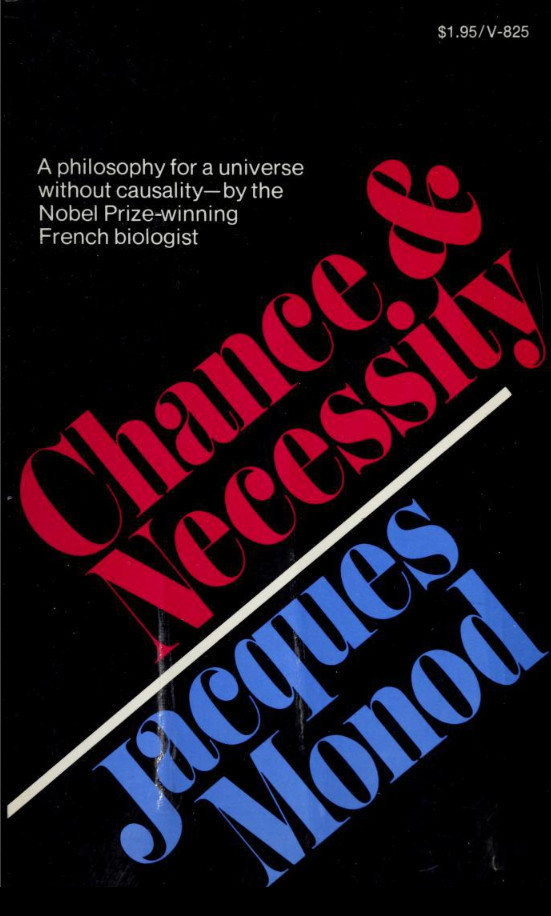



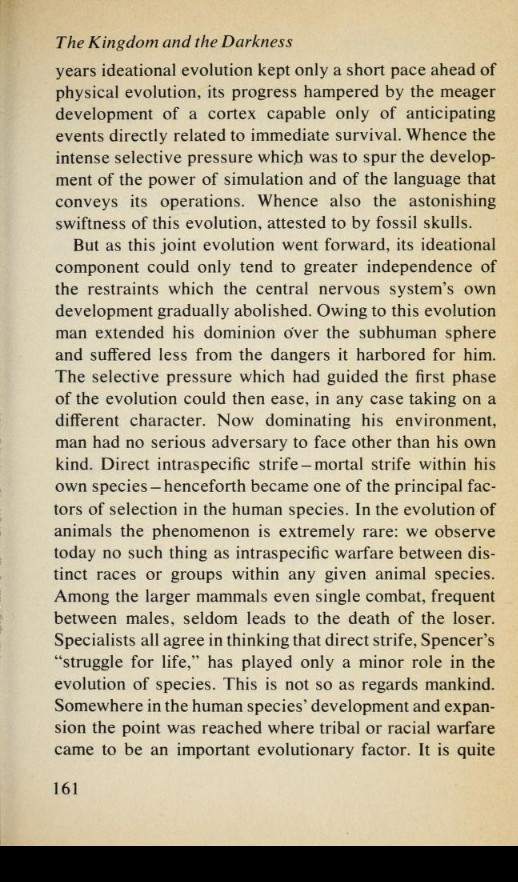




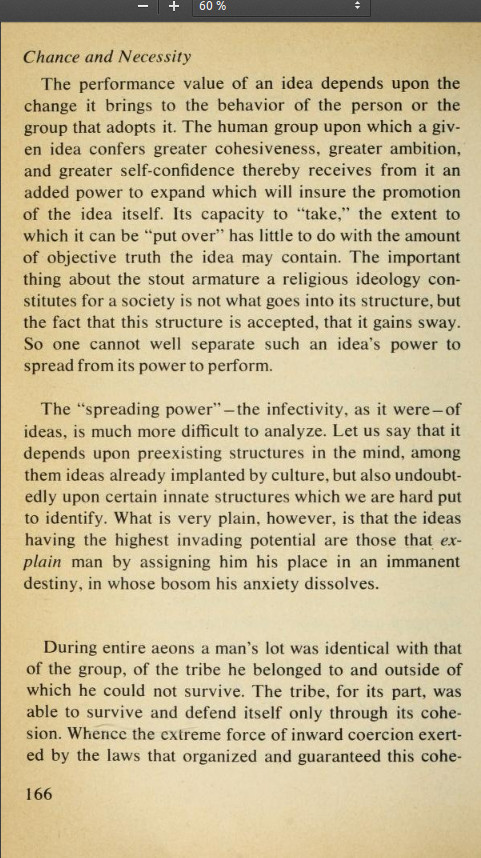

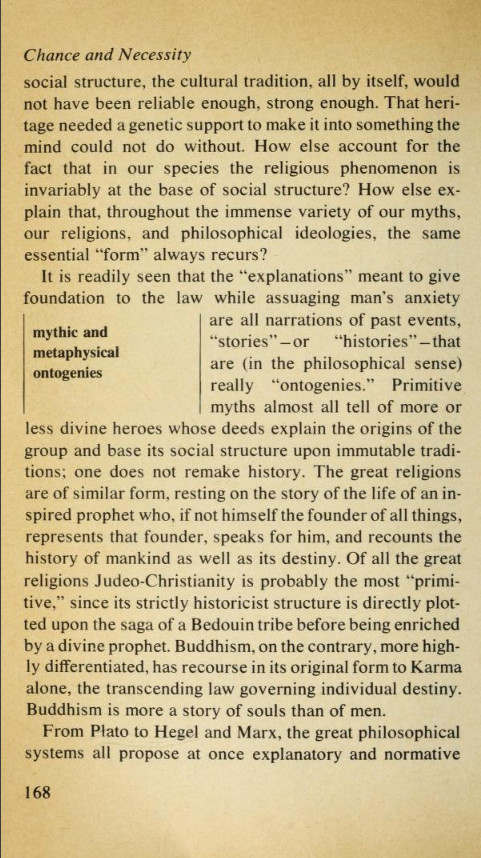







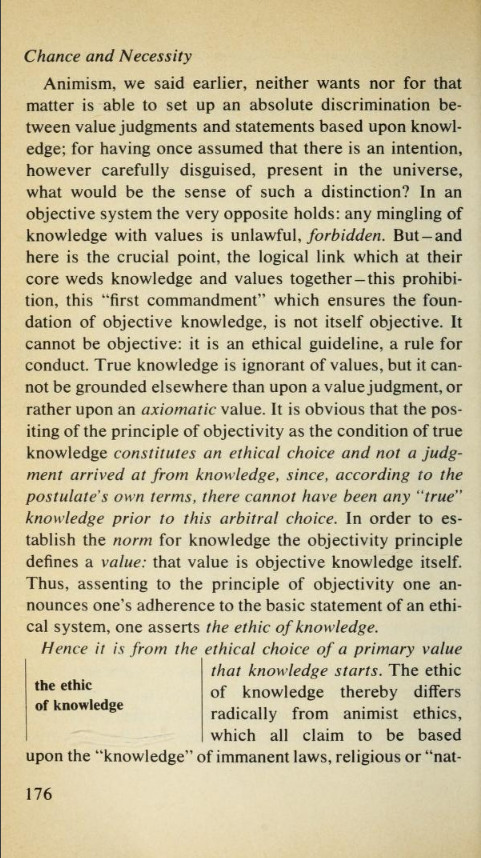
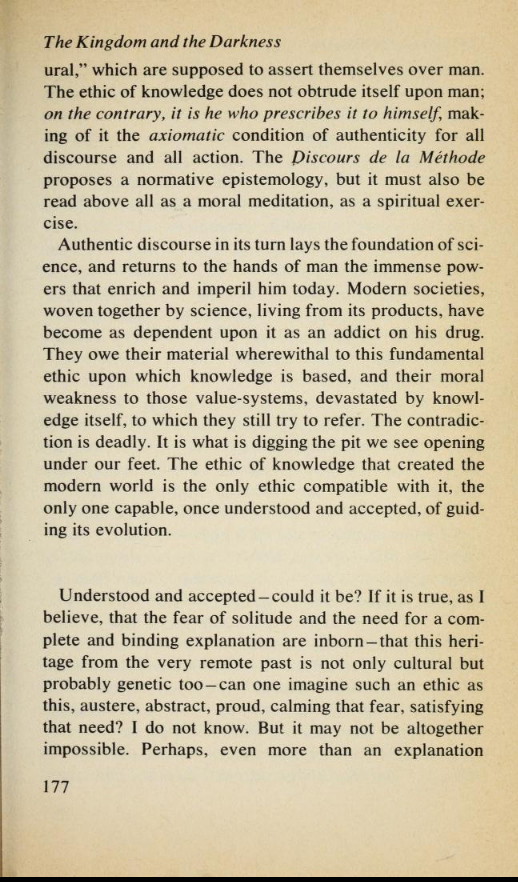


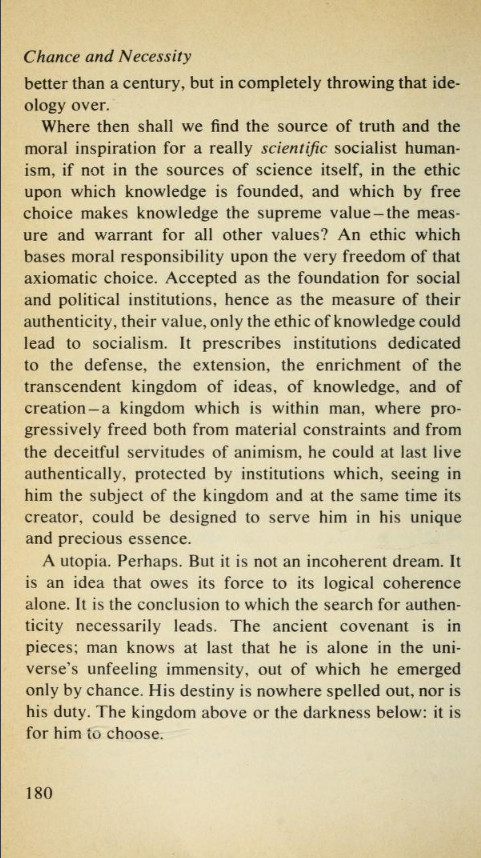
***
https://www.nature.com/articles/d41586-021-00331-5
" NEWS FEATURE
- 10 February 2021
The broken promise that undermines human genome research
Data sharing was a core principle that led to the success of the Human Genome Project
20 years ago. Now scientists are struggling to keep information free. Kendall Powell
Illustration by Ana Kova
In July 2000, David Haussler remembers crying as he watched the first fully as-sembled human genome streaming across his computer screen. He and Jim Kent, a graduate student at the time,built the first-ever web-based tool for exploring the three billion letters of the human genome. They had published the rough draft of the ge-nome on the Internet a mere 11 days after finishing the herculean task of stitching it all together - a task assigned to them as part of the Human Genome Project (HGP), the international collaboration that had been working towards this goal for a decade. It would still be several months before the group published its analysis of the genome in the pages of Nature1, but the data were ready to share.
“There it was, going out into the whole world,” recalls Haussler, scientific director of the University of California Santa Cruz Genomics Institute. Soon, every person in the world could explore it - chromosome by chromosome, gene by gene, base by base - on the web.
It was a historic moment,says Haussler.Before the HGP launched in the early 1990s, “there had not been a serious discussion about data sharing in biomedical research”, Haussler says. “The standard was that a successful investigator held onto their own data as long as they could.”
That standard clearly wouldn’t work for such a large and collaborative effort. If count-ries or scientists hoarded the data they were producing, it would derail the project. So in 1996, the HGP researchers got together to lay out what became known as the Bermuda Principles,with all parties agreeing to make the human genome sequences available in public databases, ideally within 24 hours - no delays, no exceptions.
Fast-forward two decades, and the field is bursting with genomic data, thanks to im-proved technology both for sequencing whole genomes and for genotyping them by sequencing a few million select spots to quickly capture the variation within. These efforts have produced genetic readouts for tens of millions of individuals, and they sit in data repositories around the globe. The principles laid out during the HGP, and later adopted by journals and funding agencies, meant that anyone should be able to access the data created for published genome studies and use them to power new discoveries.

In 2000, Jim Kent, a graduate student at the University of California, Santa Cruz, helped to assemble and share the results of the decade-long Human Genome Project.Credit: The Regents of the University of California. Courtesy Special Collections, University Library, University of California, Santa Cruz. UC Santa Cruz Photography Services Photographs.
If only it were that simple.
The explosion of data led governments, funding agencies,research institutes and private research consortia to develop their own custom-built databases for handling the complex and sometimes sensitive data sets. And the patchwork of repositories, with various rules for access and no standard data formatting, has led to a “Tower of Babel” situation, says Haussler.
Although some researchers are reluctant to share genome data, the field is generally viewed as generous compared with other disciplines. Still, the repositories meant to foster sharing often present barriers to those uploading and downloading data.
Researchers tell tales of spending months or years tracking down data sets, only to find dead ends or unusable files. And journal editors and funding agencies struggle to monitor whether scientists are sticking to their agreements.
Many scientists are pushing for change, but it can’t come fast enough.
Clinical genomicist Heidi Rehm says the field has come to recognize that big scien-tific advances require vast amounts of genomic data linked to disease and health-trait data. “But it isn’t compatible and shareable,” says Rehm, based at Massachu-setts General Hospital in Boston and the Broad Institute in Cambridge. “How do we get everyone in the world — patients, clinicians and researchers — to share?”
Barriers everywhere
Sequencing the human genome made it easier to study diseases associated with mutations in a single gene — Mendelian disorders such as non-syndromic hearing loss2. But identifying the genetic roots of more common complex diseases, including cardiovascular disease,cancer and other leading causes of death,required the identi- fication of multiple genetic risk factors throughout the genome.To do this,researchers in the mid-2000s began comparing the genotypes of thousands to hundreds of thou-sands of individuals with and without a specific disease or condition, in an approach known as genome-wide association studies, or GWAS.
The approach proved popular - more than 10700 GWAS have been conducted since 2005.And that has produced oceans of data,says Chiea Chuen Khor,a group leader at the Genome Institute of Singapore, who studies the genetic basis of glaucoma. A study with 10,000 people, looking at 1 million genetic markers in each, for example, says Khor, would generate a spreadsheet with 10 billion entries.
Most of these individual-level genomic data now live in ‘controlled-access’ databa-ses. These were set up to deal with the sticky legal and ethical concerns that come with genomic data that have been linked to personal information - ‘phenotype data’ that can include health-care records, disease status or lifestyle choices. Even in ano-nymized data sets, it’s technically possible that individuals can be reidentified. So, controlled-access databases vet the researchers seeking access and ensure that the data are used only for the purposes that participants consented to.
The US National Institutes of Health (NIH) requires its grant recipients to place GWAS data into its official repository, the Database for Genotypes and Phenotypes, or dbGaP. European researchers can deposit data into the European Genome-phe-nome Archive (EGA) housed at the European Bioinformatics Institute (EMBL-EBI) in Hinxton, UK. Similarly, other large generators of genomic data, such as the for-profit company 23andMe in Sunnyvale, California, and the non-profit Genomics England in London, operate their own controlled-access databases.
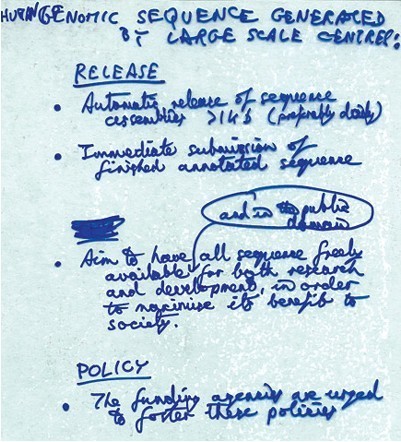
A first draft of data sharing principles for the Human Genome Project, written by John Sulston on a whiteboard in Bermuda, 1996.Credit: Richard Myers
But uploading data into some of these repositories often takes a long time. As a result, says Khor, the data are often “minimal and sparse”, because researchers are depositing just what’s required to be compliant.
Sometimes the data get stored in more than one place, and that creates other chal-lenges. Rasika Mathias, a genetic epidemiologist at Johns Hopkins University in Bal-timore, Maryland, who studies the genetics of asthma in people of African ancestry, says that decentralization is a huge problem. She is part of TOPMed, a precision-medicine programme run by the NIH’s National Heart, Lung, and Blood Institute. It consists of more than 155,000 research participants across more than 80 studies and shares its data in several repositories, including dbGaP and some university-based portals.
“It’s a remarkable resource,” says Mathias. But it’s cumbersome for an outsider to find all the pieces of available data and request access, she says. They must often provide detailed proposals and letters of support. “It’s unnecessarily difficult.”
Many look for workarounds. “I personally do not download dbGaP data, I just go straight to the researchers and ask if they want to collaborate,” says Ruth Loos, a genetic epidemiologist at the Icahn School of Medicine at Mount Sinai in New York City. Several years ago, she tried to access a dbGaP data set, filing multiple rounds of digital paperwork, only to be rejected. “Even logging into dbGaP can be a pain. It’s just not researcher-friendly,” she says.
Stephen Sherry, acting director of the NIH’s National Center for Biotechnology Infor-mation in Bethesda, Maryland, which runs the dbGaP,acknowledges that the proces- ses to submit and access data are “imperfect and painful”. And the complex, hetero-geneous data require case-by-case review, which cannot simply be sped up by throwing “more people at the crank to turn it faster”.
But, Sherry says, the NIH is investing in modernizing the system to make it more streamlined and flexible. Carrie Wolinetz, associate director for science policy at the NIH, says it is yet to be determined whether the remedy will be a dbGaP 2.0 or an alternative resource. “Do you put in a stop-gap measure, or is it time to invest in a whole bathroom renovation?” she asks.
For all the problems that controlled access causes in sharing genome data, many re-searchers say databases such as dbGaP and the UK BioBank, which holds genomic data on 500,000 people, are still invaluable. Mathias is fiercely protective of the parti-cipants in TOPMed and sees merit in the protection that controlled access provides. Like many, she would like to see the repositories better resourced. But, she says, “I am an advocate for the checks and balances”.

Craig Venter (left) of Celera Genomics and Francis Collins (centre),then at the Natio- nal Human Genome Research Institute, met in Washington in 2000 to announce the completion of the first drafts of the human genome.Credit: Ron Sachs /Shutterstock
And others are happy to have access,even if it is hard to obtain.“It’s out of our scope to generate that amount of data,” says Melanie Bahlo, who runs a statistical-genetics lab at the Walter and Eliza Hall Institute of Medical Research in Melbourne, Austra-lia. Her lab is more than willing to wade through the digital paperwork to use the dbGaP, and has done so for more than ten projects. She also recently spent a fruit-less six months chasing after a data set that was supposed to be publicly available through a research institute’s data portal, but wasn’t.
“Nothing is harder than getting data out of dbGaP and EGA,” says Khor, “unless it’s getting it from a researcher who is unwilling to share.”
The sharing police
Twenty years on from the HGP, there is no specific universal policy that says re-search groups have to share their human-genome data, or share them in a particular format or database. That said, many journals have continued to abide by the Bermu-da Principles, requiring that genomic data be shared in approved databases at the time of publication. Enforcement of these policies can be hit or miss.
Michelle Trenkmann, senior editor for genetics and genomics at Nature in London, says that authors are often reluctant to share, citing concerns over participant priva-cy, consent or national or corporate rules governing who owns the data. “What’s re-markable, is that, as a field, geneticists expect the data to be shared, but sometimes they do not want to share their own data",she says. Trenkmann pushes back in such cases, and if the challenges can’t be overcome, the authors must spell out their reasons directly in the paper for transparency. (Nature’s news team is editorially independent from its journal team.)
The journal Genome Research, has a ‘no exceptions’ policy. Executive editor Hillary Sussman explains that the journal’s editors will work through data-sharing obstacles with authors on a case-by-case basis to find solutions. This can go as far as asking authors to reapply for approval from their institutional review board, going back to participants to reobtain their consent or rerunning an analysis after removing unsha-reable data. The journal has turned away authors who state upfront that they cannot share data. “The community and the funders demand this transparency and reproducibility,” she says.
But even when authors do agree to share data, editors and reviewers have limited ability to confirm that it is being done.They might not have the time - or the access to controlled-access databases - to check data quality, formatting or completeness.
Trenkmann says funders should require researchers to have a concrete data-sharing plan from the outset of a project. This could help to shift attitudes so that researchers see sharing as a duty, she says.
An NIH-wide data-sharing policy to be implemented in January 2023 does just that. It requires all NIH grant applicants to put a Data Management and Sharing (DMS) Plan into their grant proposals and allows researchers to allocate some of their budget to the task.
This should ensure that data sharing is aligned both with ethical and privacy consi-derations, and with the FAIR principles - which mean that data must be findable, accessible, interoperable and reusable,says Carolyn Hutter, director of the National Human Genome Research Institute’s (NHGRI) Division of Genome Sciences in Be-thesda. “That does not mean, I threw my data over a wall and hope someone caught it,” she says.
“The enforcement part of it is tricky,” Hutter adds,“because data sharing often comes at the very end of the project.” And like journal editors, grant administrators can only do spot checks of any data-sharing accession numbers that appear in annual progress reports.
Searching for solutions
There could be ways to share more simply without falling foul of proprietary or privacy issues. Many genomic stakeholders agree that an aggregated form of GWAS data, called GWAS summary statistics, can and should be shared broadly and freely. These summaries include the aggregated scores for each genetic variant found to be associated with a disease or condition across multiple genomes. They are easier for researchers to work with, and they protect participant privacy.
Many research consortia do share these on their websites or portals. But an open-access collaboration between EMBL-EBI and the NHGRI,called the GWAS Catalog3, is working towards a centralized, standardized solution.
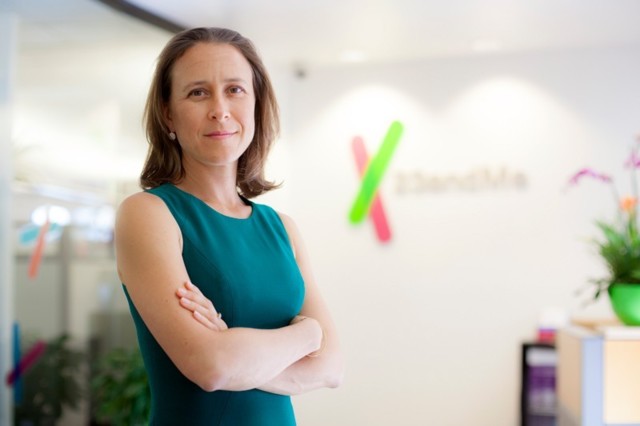
The rise of personal genomics companies such as 23andMe, co-founded by Anne Wojcicki in 2006, added new wrinkles to genome data-sharing practices.Credit: Peter DaSilva/NYT/Redux/eyevine
Starting in 2020, the GWAS Catalog gave researchers a way to submit their summa-ry statistics along with metadata describing the study and participants. In return, researchers get a prepublication accession ID to use in preprints and submitted manuscripts.
But many researchers say that summary statistics are not sufficient for advancing genomic science. “That’s a major threat to GWAS,” says Chris Amos, a genetic epi-demiologist who studies lung cancer at Baylor College of Medicine in Houston, Te-xas. Researchers need the individual-level genome data and the linked phenotypic trait data to reveal exactly how genetic variation plays out in disease.They also need the full data to check the science. “If you don’t have the raw data, you can’t look at the quality. That is not good enough to make a reproducible finding,” Amos says.
And the owners of the data for very large cohorts, such as 23andMe and Genomics England, don’t give unrestricted access to their summary statistics. They cite con-cerns over participants’ data privacy and the wish to retain ownership of their data. In effect, they run their own controlled-access databases, with custom processes for accessing and reanalysing their data. A precondition for working with much of their data is allowing the companies to share authorship of the resulting work. Bahlo says these kinds of requirements set too high a bar for her and other bioinformaticians who wish to crunch data from Genomics England’s 100,000 Genomes Project.
Hutter acknowledges that not all the current growing pains of genomic data sharing can be fixed simply through improvements to the dbGaP or by sharing summary statistics in the GWAS Catalog. “The dbGaP wasn’t positioned to evolve and handle every new type of data,” she says. For example, the cost of storing data from whole genomes is very different from that for GWAS data. As such, the NHGRI has created a cloud-based infrastructure known as the Analysis, Visualization, and Informatics Lab-space (AnVIL), where researchers can share and analyse across large genomic data sets, including whole genome and exome sequences.
Another NIH initiative is the Researcher Auth Service (RAS), which would authorize researchers to access AnVIL, the dbGaP and several other data resources. “The vision is that we’d push this out like a visa stamp,” says Sherry, allowing researchers to ultimately merge and analyse data at will in cloud-based systems. “We’re building one of the first systems of library cards for researchers,” says Sherry.
Haussler and some other big-data wranglers also have ideas. As data-sharing frust-rations were mounting in 2013, Haussler, along with David Altshuler, Eric Lander and other international colleagues laid the groundwork for the Global Alliance for Geno-mics and Health, or GA4GH (see go.nature.com/3app3xr). It started with the same ideals as the HGP. “We’d get the world to share data on one big database, and we’d all agree on how we’d use that data, and Kumbaya,” says Haussler. “Very quickly, it became evident that that was utterly impossible.”
Instead, the GA4GH now focuses on creating standards for the multitude of genomic databases around the world. Its working hypothesis is that it will be technically pos-sible to harmonize data (like the GWAS Catalog on a grander scale) and to federate, or loosely link, the disparate data warehouses.
GA4GH chief executive Peter Goodhand uses the analogy of global mobile-phone communications. There’s huge competition between mobile-phone makers and ser-vice providers, but at the end of the day, they all have to work on the same network. “For true interoperability to take place, there have to be working relationships between the providers,” says Goodhand. “You can set up the systems that permit the sharing and make it easier.”
Scientists used a GA4GH standard to create the Matchmaker Exchange, for example. This service lets clinicians and researchers working on the rarest of rare diseases search a single federated network of eight international databases to find individuals with a similar genotype or phenotype to a case they’re working on. If a match is returned, both parties are connected in a way that protects both patient confidentiality and research ownership and authorship. The NIH’s RAS will also use a GA4GH standard, called the Data Repository Service, a software interface that helps different repositories to communicate.
Bahlo and others say that data federation efforts become even more important as the field pivots to digging deeper into phenotype data, which have grown in scope and complexity. “That data comes in all sorts of forms — environmental exposures, smoking status, medical imaging data,” says Bahlo.
She and others see data federation as a great opportunity to inject global equity into genomic data sharing. Researchers from developing countries could access and work with data sets without needing to generate their own data or have their own su-percomputing resources.And better data sharing should also improve representation of non-white, non-European global ancestries. Under-representation is especially stark for continental African ancestries, which make up less than 0.5% of all GWAS participants4.
Haussler thinks that positive peer pressure should convince scientists to share in better ways. The need is only growing. Twenty years after releasing the first human genome to the Internet, his team has built a way for anyone to explore the SARS-CoV-2 viral genome5.
“Data should be a living thing,” says Haussler. “I want to click on it and play with it immediately. That should be the motivation. If you don’t share your data, you can’t do that.”
Nature 590, 198-201 (2021)
doi: https://doi.org/10.1038/d41586-021-00331-5
***
Rotalla on kuudenlaisia neuroneita suhteessa geeneienluentaan:
https://www.nature.com/articles/d41586-022-01640-z
" NEWS AND VIEWS
- 06 July 2022
A gene-expression axis defines neuron behaviour
An essential step towards understanding how the brain works is to create a cata-logue of brain-cell types. Cell-type classification has been transformed by single-cell transcriptomics, which reveals the entire repertoire of expressed genes (the trans-criptome) in each of thousands or millions of single cells isolated from a brain region of interest1. But what do these cell types do, and what parts do they play in neuronal circuits? Writing in Nature, Bugeon et al.2 attempt to address these questions by de-veloping an approach to measuring the in vivo activities of transcriptomically defined cell types in the mouse visual cortex.
***
https://scitechdaily.com/a-new-technology-could-help-solve-a-dna-mystery/
" A New Technology Could Help Solve a DNA Mystery
The human genome’s inner workings could be revealed through new Cornell-developed technology.
Researchers from Oxford Nanopore Technologies, Weill Cornell Medicine, and the New York Genome Center have created a new technique to evaluate the three-dimensional structure of the human DNA, or how the genome folds, on a massive scale. The genome is the entire set of genetic instructions, either DNA or RNA, that allow an organism to function.
Using this technique, the researchers showed that groups of simultaneously interac-ting regulatory elements in the genome, as opposed to pairs of these elements, may influence cell activity, including gene expression. Their research, which was recently published in the journal Nature Biotechnology, may help clarify the connection between cellular identity and genome structure.
“Knowing the three-dimensional genome structure will help researchers better understand how the genome functions, and particularly how it encodes different cell identities,” said senior author Dr. Marcin Imieliński, associate professor of pathology and laboratory medicine and computational genomics in computational biomedicine at Weill Cornell Medicine and a core member of the New York Genome Center. “The ways that we’ve had to study genome structure have given us amazing insights, but there have also been key limitations,” he said.
For example, previous technology to examine the genome’s three-dimensional struc-ture enabled researchers to investigate how often two loci, or physical sites on the genome, interact with one another. Traditionally, pairs of loci known as enhancers and promoters — components in the genome that interact with one another to control gene expression — have been discovered.
Information about these pairings offers incomplete insight into genome structure and function. For instance, linking a folding pattern to how the genome encodes for a specific cell identity — like a liver, lung, or epithelial cell — has been difficult, said Dr. Imieliński, who is also a member of the Englander Institute for Precision Medicine and the Sandra and Edward Meyer Cancer Center at Weill Cornell Medicine. Scien-tists have theorized that this folding influences gene expression. “But how cell types are encoded, particularly in the structure of DNA, has been a mystery,” he said.
They also developed statistical methods to determine which locus groupings were important, based on whether they interacted cooperatively to affect gene expression. “Many three-dimensional interactions of the genome are not important,” Dr. Imieliński said. “Our analytic methods help us prioritize the group interactions that are likely to matter for genome function.” As a key finding of the study, the researchers found that the most significant cooperative groupings of DNA elements occurred around genes associated with cell identity.
Future experiments will explore which specific groupings of genomic components are essential for various aspects of cell identity. The new technology may also help researchers to understand how stem cells, the immature, master cells of the body, differentiate into different cell types.
Reference: “Identifying synergistic high-order 3D chromatin conformations from genome-scale nanopore concatemer sequencing” by Aditya S. Deshpande, Netha Ulahannan, Matthew Pendleton, Xiaoguang Dai, Lynn Ly, Julie M. Behr, Stefan Schwenk, Will Liao, Michael A.Augello, Carly Tyer, Priyesh Rughani, Sarah Kudman, Huasong Tian, Hannah G. Otis, Emily Adney, David Wilkes, Juan Miguel Mosquera, Christopher E. Barbieri, Ari Melnick, David Stoddart, Daniel J. Turner, Sissel Juul, Eoghan Harrington and Marcin Imieliński, 30 May 2022, Nature Biotechnology.
DOI: 10.1038/s41587-022-01289-z



